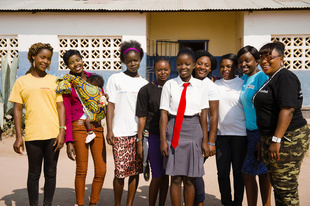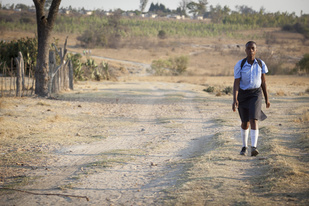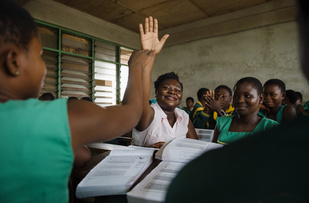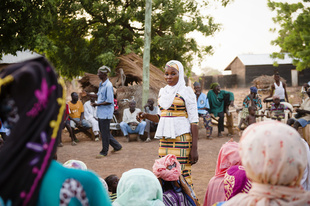Worldwide, 130 million girls are out of school
Over the past 25 years the Campaign for Female Education, Camfed, has delivered sustainable solutions to girls’ exclusion, locally tailored and galvanizing community resources to break down the barriers that keep girls out of school. Camfed not only broadens access to education, but pushes up the quality of education and learning outcomes, preparing young women for productive and independent lives after school.

A Camfed scholar with Camfed alumnae (CAMA members) in rural Zambia. Photo: Eliza Powell/Camfed
Why girls’ education?
Population growth increases the competition for resources and weakens our ability to deal with climate change. By tackling birth rates through investment in girls’ education, we can achieve the greatest beneficial impact: both improving lives while also making those populations, and the world, more resource secure.
World Bank statistics show that the difference in family size for women who have no schooling and those with 12 years of schooling is 4 to 5 children per woman. A quality education, which includes information and guidance around family planning and female reproductive health, can open up more personal choice and greater financial independence for young women. Educated girls earn up to 25% more per year in secondary school, reinvest 90% in their families, and are three times less likely to be HIV positive. They marry later, have smaller, healthier families, and invest in their children’s education.

Girl walking to a Camfed partner school in rural Zimbabwe Photo: Jon Pilch/Camfed
Educating girls therefore results in helping populations become more resilient. It reduces resource pressures, increases the chance of lasting development success through through higher resource security, particularly in low-income rural communities, where up to 80% of the population depend on agriculture for survival. Women are the most vulnerable to the impacts of insufficient resource access, and the devastating effects of droughts and floods. Educated women can access and share the skills and knowledge needed to mitigate the effects of resource constraints and climate change.
Camfed’s Model of Girls’ Education
Camfed’s model sees girls’ education as the starting point for social change. We unlock the leadership potential of groups of girls and women at the margins of society by creating networks of support in schools and communities. This has created a multiplier effect like no other, with each alumna supporting at least two more girls outside of her immediate family to go to secondary school.

CAMA Learner Guide Pearl with students in rural Ghana. Photo: Eliza Powell/Camfed
By the beginning of 2018, the Camfed community had directly supported more than 2.6 million children in 5,745 partner schools schools across five countries, tackling the barriers to marginalized girls’ school access, retention, progression and completion. At secondary level, where the exclusion of disadvantaged adolescent girls is particularly acute, Camfed and its partners provide targeted bursaries for individual girls, providing the financial resources to cover school fees, exam fees, school uniforms, school supplies and sanitary wear, as well as disability aids, for example, depending on individual circumstances.
As part of our program to improve education outcomes for the most marginalized children, Camfed trains young women school graduates in its CAMA alumnae network as Learner Guides. As female role models and mentors, Learner Guides deliver a contextualized life skills and sexual and reproductive health curriculum, helping to raise children’s confidence and aspirations, and supporting students in their studies.
Camfed’s Model of Women’s Empowerment
Education and learning don’t end at the school gates. In marginalized rural communities there can be a big gap between what children learn at school, and what young people need to live independent and fulfilling lives. Camfed provides support to the young women of CAMA in the form of training, business grants, and post-secondary education, investing in young women’s capacity as leaders, professionals, and entrepreneurs.

Hawa was the first girl in her village to go to secondary school. She is a Camfed alumna (CAMA member) and now an elected District Assembly Person, who has changed attitudes toward girls’ education in her community. Photo: Eliza Powell/Camfed
Through CAMA — possibly the most powerful and fastest growing professional women association with already 120,000 members by early 2018 — young women develop more secure livelihoods and establish themselves as powerful role models and philanthropists in their communities. CAMA members are innovative farmers practicing sustainable agriculture, social entrepreneurs, teachers, lawyers, doctors, and political leaders, putting themselves at the forefront of dismantling the barriers to girls’ education and women’s empowerment, and rallying everyone in their communities to do the same.
In fact, many leading staff in Camfed are themselves CAMA associates, having been able to access education through the very program they now lead.
Interested in population action? Consider supporting Camfed!
